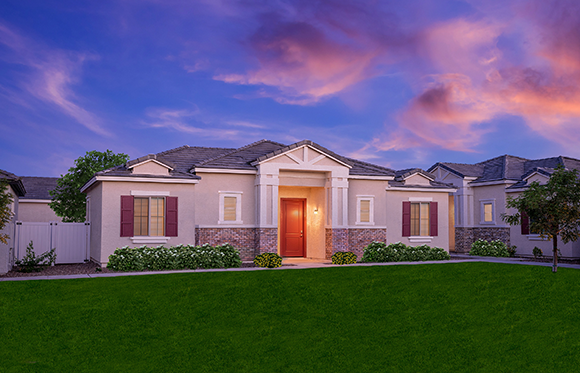For Rent
The hottest trend in real estate today? Build to rent single-family homes.
By Nora Burba Trulsson
At a Christopher Todd Communities (christophertodd.com) development in Glendale, a series of transitional-style homes open up onto green space and include small, fenced backyards. Inside, amenities include granite countertops, Shaker-style cabinetry, a full-sized washer and dryer and pale plank flooring.
On the other side of metro Phoenix, The Havenly Fountain Hills (havenlyfountainhills.com) community’s homes include quartz countertops, keyless entry, voice command switches and access to a clubhouse featuring a heated pool and putting green.
However, these newly built, one-, two- and three-bedroom single-family homes are not for sale. Instead, they are at the fore of the hottest trend in real estate—build to rent (BTR) or single-family rental (SFR). While renting single-family homes is nothing new—landlords have always purchased existing homes to use as rentals—creating new-home communities specifically for the rental market is now booming—and a trend that had its start just over ten years ago.
“This business model on an institutional scale is new,” says Mark Stapp, director of real estate programs at ASU’s W.P. Carey School of Business. “The first build-to-rent community was located in Tucson, developed in 2010. The concept quickly moved up to Phoenix and other Sunbelt locations.”
According to Stapp, who also has a background in development and planning, the BTR model launched as a result of the recession, when many people lost their homes. “Everyone needs a place to live,” he says, “but for a lot of people,
was—and is—out of reach. If you have pets or kids, apartments aren’t great either. These communities filled a need in the marketplace.”
BTR communities are by and large characterized by smaller floor plans, often one- or two-bedroom models. Most of the homes are single story and detached, an appealing factor for long-time apartment dwellers, meaning nobody is above or below you. Many of the communities are gated and have shared amenities, such as parks, walking paths and those clubhouses with pools. Another amenity? Repairs are handled by the community’s management.
Christopher Todd Communities, which has numerous projects in Arizona and more in the pipeline, currently has rental rates that range from $1,420 to $2,968 per month, depending on location. The Havenly’s lease rates start at $2,210.
Initially, BTR community developers did the projects on their own, Stapp explains. Recently, they’ve been partnering with single-family homebuilders. Christopher Todd Communities, for example, is now partnering with builder Taylor Morrison on projects. In other cases, Stapp notes, established new-home builders are launching their own BTR projects, such as Keystone Homes, with its Havenly Fountain Hills. He estimates that there are thousands—if not tens of thousands—of these BTR units in Arizona, with more to come.
With today’s housing shortage and the long-held American dream of home ownership, why not just build affordable “starter home” communities instead of BTR developments? “With land prices, as well as labor and materials costs, the ability to construct a home and sell it at, basically, below market rate is hard,” says Stapp. “To find cheaper land, you’d really have to go out to the periphery of a metro area, like beyond the White Tank Mountains in Phoenix or to a town like Coolidge. That’s why rental homes work in communities with tight housing inventories.”
In the meantime, BTR communities are proliferating in Arizona and other states. “These homes definitely appeal to millennials, who find it hard to buy a home in
today’s market and want something beyond an apartment,” says Stapp. “On the other end of the spectrum, the older segment of the population, such as empty nesters, like the freedom of not owning a house. This product has come into the market because there is a need.”

